 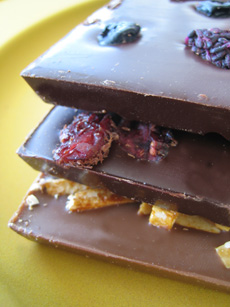
Artisanal bars from Michael Mischer Chocolates of Oakland, California. Photo by Melody Lan | THE NIBBLE.
|
KAREN HOCHMAN’s first word was not cacahuatl...but as her mother will attest, it was pretty close.
|
|
May 2006
Revised January 2009
|
 |
From Pod to Palate: The Birth Of The Bar
Page 5: Making The Chocolate ~ Winnowing, Grinding & Pressing The Beans
This is Page 5 of a 10-page article on chocolate production. Click on the black links below to visit other pages.
Making The Chocolate
7. Winnowing (Shelling)
 Winnowing means shelling, and prior to the Industrial Revolution, this was a manual process (in many third world counties, grain is still winnowed by hand). After the beans have been roasted and cooled, their shells are thin and brittle. They move to a machine called the winnower, which cracks open the shells. Air blows away the cracked outer shell and the husk, and sorts the remaining nibs by size. The nib is the heart of the bean (also called the kernel or the meat), from which the chocolate is made. Nibs (photo above) contain about 400 different chemical compounds responsible for the flavor of the final Winnowing means shelling, and prior to the Industrial Revolution, this was a manual process (in many third world counties, grain is still winnowed by hand). After the beans have been roasted and cooled, their shells are thin and brittle. They move to a machine called the winnower, which cracks open the shells. Air blows away the cracked outer shell and the husk, and sorts the remaining nibs by size. The nib is the heart of the bean (also called the kernel or the meat), from which the chocolate is made. Nibs (photo above) contain about 400 different chemical compounds responsible for the flavor of the final  chocolate product. Modern factories no longer use old-fashioned equipment like the antique at the right, which still gets the job done for the Grenada Chocolate Company. chocolate product. Modern factories no longer use old-fashioned equipment like the antique at the right, which still gets the job done for the Grenada Chocolate Company.
The roasted nibs are now ready to be ground into a paste that will eventually become chocolate.
Photo of winnower courtesy of Grenada Chocolate Company.
8. Grinding / Mélangeur
There are usually two stages of grinding in the manufacture of fine chocolate. In the first stage, the nibs (photo above) are ground into a thick paste similar to fresh-ground peanut butter, called the chocolate chocolate liquor (photo at right). The latter is 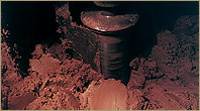 a confusing name to anyone outside the industry, as it is neither liquid nor contains any alcohol. To add to the confusion, chocolate liquor is also called cocoa or cacao liquor, chocolate mass, cocoa mass, cocoa solid, or pâté de cacao (cocoa paste or chocolate paste). In the United States Food Standards of Identity, it is known simply as chocolate. Once further refined, it also is called unsweetened baking chocolate. Chocolate liquor is the main ingredient in chocolate. Photo courtesy of Stollwerck. a confusing name to anyone outside the industry, as it is neither liquid nor contains any alcohol. To add to the confusion, chocolate liquor is also called cocoa or cacao liquor, chocolate mass, cocoa mass, cocoa solid, or pâté de cacao (cocoa paste or chocolate paste). In the United States Food Standards of Identity, it is known simply as chocolate. Once further refined, it also is called unsweetened baking chocolate. Chocolate liquor is the main ingredient in chocolate. Photo courtesy of Stollwerck.
 Since cacao beans are more than half fat, the chocolate liquor is made up of rich cocoa butter (53% to 60% depending on the varietal) with fine cocoa particles suspended in it. The heat and friction generated by the grinding metal plates causes the cocoa butter in the nib to melt into a fluid mass (photo at right), hence the name “chocolate liquor.” The chocolate liquor is not yet officially chocolate, but it smells like it! Photo courtesy of Amano Artisan Chocolate. Since cacao beans are more than half fat, the chocolate liquor is made up of rich cocoa butter (53% to 60% depending on the varietal) with fine cocoa particles suspended in it. The heat and friction generated by the grinding metal plates causes the cocoa butter in the nib to melt into a fluid mass (photo at right), hence the name “chocolate liquor.” The chocolate liquor is not yet officially chocolate, but it smells like it! Photo courtesy of Amano Artisan Chocolate.
For eating chocolate, the appropriate amount of sugar is added (except for 100% cacao bars). The size of the particles in the chocolate mass is now about 100 microns. To avoid a grainy taste in the finished chocolate, another grinding takes place to reduce the particle size to about 18 microns (the tongue can sense grains of 18 microns or larger).
Chocolate liquor destined to be made into chocolate candy and confections then goes to be blended (Step 10). That which will be made into cocoa powder goes to Pressing.
9. Pressing (For Cocoa Powder)
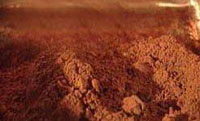 If cocoa powder is being made, the chocolate liquor is further processed into “press cake” or pressed cake, and cocoa butter. The chocolate liquor or mass is put into hydraulic presses and extremely high pressure, 6000 pounds per square inch, is applied to drain off the clear, golden liquid cocoa butter. The press cake that is left is cooled, pulverized and sifted into cocoa powder. Photo of cocoa powder courtesy of CocoaTree.org. If cocoa powder is being made, the chocolate liquor is further processed into “press cake” or pressed cake, and cocoa butter. The chocolate liquor or mass is put into hydraulic presses and extremely high pressure, 6000 pounds per square inch, is applied to drain off the clear, golden liquid cocoa butter. The press cake that is left is cooled, pulverized and sifted into cocoa powder. Photo of cocoa powder courtesy of CocoaTree.org.
Note that some companies sell “drinking chocolate,” which is sweetened cocoa or sweetened chocolate discs or squares, ready to be mixed with hot milk or water to become a beverage.
Continue To Page 6: Blending The Cacao
Go To The Article Index Above
“Pocket Chocolate”
Belgian chocolatier NewTree makes boxes of 3 individually wrapped 0.32-ounce mini-bars that are just perfect for an invigorating snack. The Bittersweet bars include:
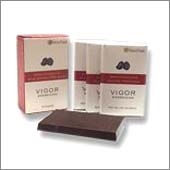 |
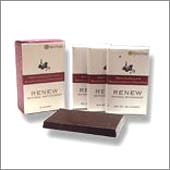 |
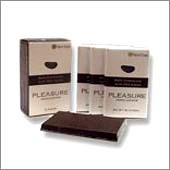 |
| NewTree “Vigor” Bars. 73% cacao dark chocolate mini-bars enhanced with coffee and guarana, a South American berry known for its revitalizing properties. A peppy blend, Vigor stimulates your mind and body. It’s also a good source of Vitamin D. Box of 3 mini-bars, $3.00. Click here for more information. |
NewTree “Renew” Bars. 73% cacao dark chocolate mini-bars enhanced with blackcurrant and grape extract,which are powerful antioxidants and polyphenols that are known to help reduce the risk of cardiovascular disease. Renew also contains a healthy dose of Vitamin D. Box of 3 mini-bars, $3.00. Click here for more information. |
NewTree “Pleasure” Bars. 73% cacao dark chocolate mini-bars that are a fine source of fiber, iron, magnesium and vitamin D. Pleasure is also high in antioxidants that improve muscle function, plus phosphorous that increases energy and Vitamin D to maintain good bone structure. Box of 3 mini-bars, $3.35. Click here for more information. |
| |
Milk chocolate: |
Milk chocolate: |
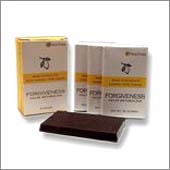 |
 |
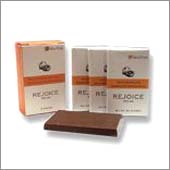 |
| NewTree “Forgiveness” Bars. 73% cacao dark chocolate mini-bars are a zesty lemon-infused chocolate rich in natural fiber from cactus extracts. Like magic, the lemon and cactus help eliminate the fat that is contained in the chocolate. Forgiveness contains enough cactus fiber to decrease the intake of calories by 25% compared with other 73% cocoa chocolates (NewTree or any other brand) that does not contain this ingredient. It’s very forgiving! Click here for more information. |
NewTree “Tranquility” Bars. These milk chocolate mini-bars help you to escape stress by combining the sensuous, smooth silkiness of milk chocolate with essence of lime blossom and the finest lavender from Provence, in sunny southern France. Tranquility transports you at any time of day, but is especially nice before bedtime. Click here for more information. |
NewTree “Rejoice” Bars. These silky-smooth milk chocolate mini-bars contain crisped rice, natural lime blossoms, and bitter orange cultivated around the Mediterranean Sea. Bitter orange and lime blossom are known for their blissful effects, while crisped rice adds a contrasting crunch. Rejoice helps one unwind and relax. Click here for more information. |

|





 Winnowing means shelling, and prior to the Industrial Revolution, this was a manual process (in many third world counties, grain is still winnowed by hand). After the beans have been roasted and cooled, their shells are thin and brittle. They move to a machine called the winnower, which cracks open the shells. Air blows away the cracked outer shell and the husk, and sorts the remaining nibs by size. The nib is the heart of the bean (also called the kernel or the meat), from which the chocolate is made. Nibs (photo above) contain about 400 different chemical compounds responsible for the flavor of the final
Winnowing means shelling, and prior to the Industrial Revolution, this was a manual process (in many third world counties, grain is still winnowed by hand). After the beans have been roasted and cooled, their shells are thin and brittle. They move to a machine called the winnower, which cracks open the shells. Air blows away the cracked outer shell and the husk, and sorts the remaining nibs by size. The nib is the heart of the bean (also called the kernel or the meat), from which the chocolate is made. Nibs (photo above) contain about 400 different chemical compounds responsible for the flavor of the final  chocolate product. Modern factories no longer use old-fashioned equipment like the antique at the right, which still gets the job done for the Grenada Chocolate Company.
chocolate product. Modern factories no longer use old-fashioned equipment like the antique at the right, which still gets the job done for the Grenada Chocolate Company.  a confusing name to anyone outside the industry, as it is neither liquid nor contains any alcohol. To add to the confusion, chocolate liquor is also called cocoa or cacao liquor, chocolate mass, cocoa mass, cocoa solid, or pâté de cacao (cocoa paste or chocolate paste). In the United States Food Standards of Identity, it is known simply as chocolate. Once further refined, it also is called unsweetened baking chocolate. Chocolate liquor is the main ingredient in chocolate.
a confusing name to anyone outside the industry, as it is neither liquid nor contains any alcohol. To add to the confusion, chocolate liquor is also called cocoa or cacao liquor, chocolate mass, cocoa mass, cocoa solid, or pâté de cacao (cocoa paste or chocolate paste). In the United States Food Standards of Identity, it is known simply as chocolate. Once further refined, it also is called unsweetened baking chocolate. Chocolate liquor is the main ingredient in chocolate.  Since cacao beans are more than half fat, the chocolate liquor is made up of rich cocoa butter (53% to 60% depending on the varietal) with fine cocoa particles suspended in it. The heat and friction generated by the grinding metal plates causes the cocoa butter in the nib to melt into a fluid mass (photo at right), hence the name “chocolate liquor.” The chocolate liquor is not yet officially chocolate, but it smells like it!
Since cacao beans are more than half fat, the chocolate liquor is made up of rich cocoa butter (53% to 60% depending on the varietal) with fine cocoa particles suspended in it. The heat and friction generated by the grinding metal plates causes the cocoa butter in the nib to melt into a fluid mass (photo at right), hence the name “chocolate liquor.” The chocolate liquor is not yet officially chocolate, but it smells like it!  If cocoa powder is being made, the chocolate liquor is further processed into “press cake” or pressed cake, and cocoa butter. The chocolate liquor or mass is put into hydraulic presses and extremely high pressure, 6000 pounds per square inch, is applied to drain off the clear, golden liquid cocoa butter. The press cake that is left is cooled, pulverized and sifted into cocoa powder.
If cocoa powder is being made, the chocolate liquor is further processed into “press cake” or pressed cake, and cocoa butter. The chocolate liquor or mass is put into hydraulic presses and extremely high pressure, 6000 pounds per square inch, is applied to drain off the clear, golden liquid cocoa butter. The press cake that is left is cooled, pulverized and sifted into cocoa powder. 




